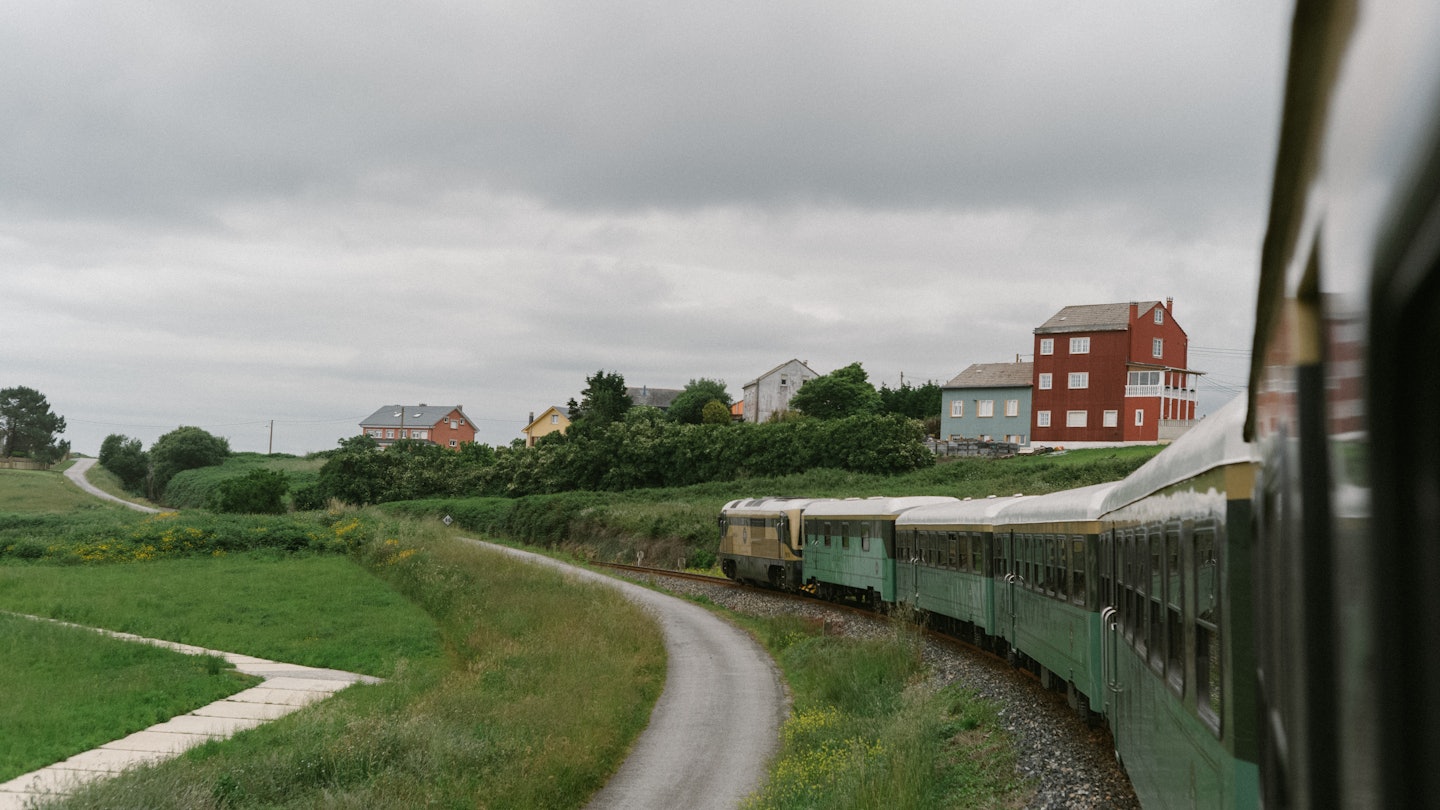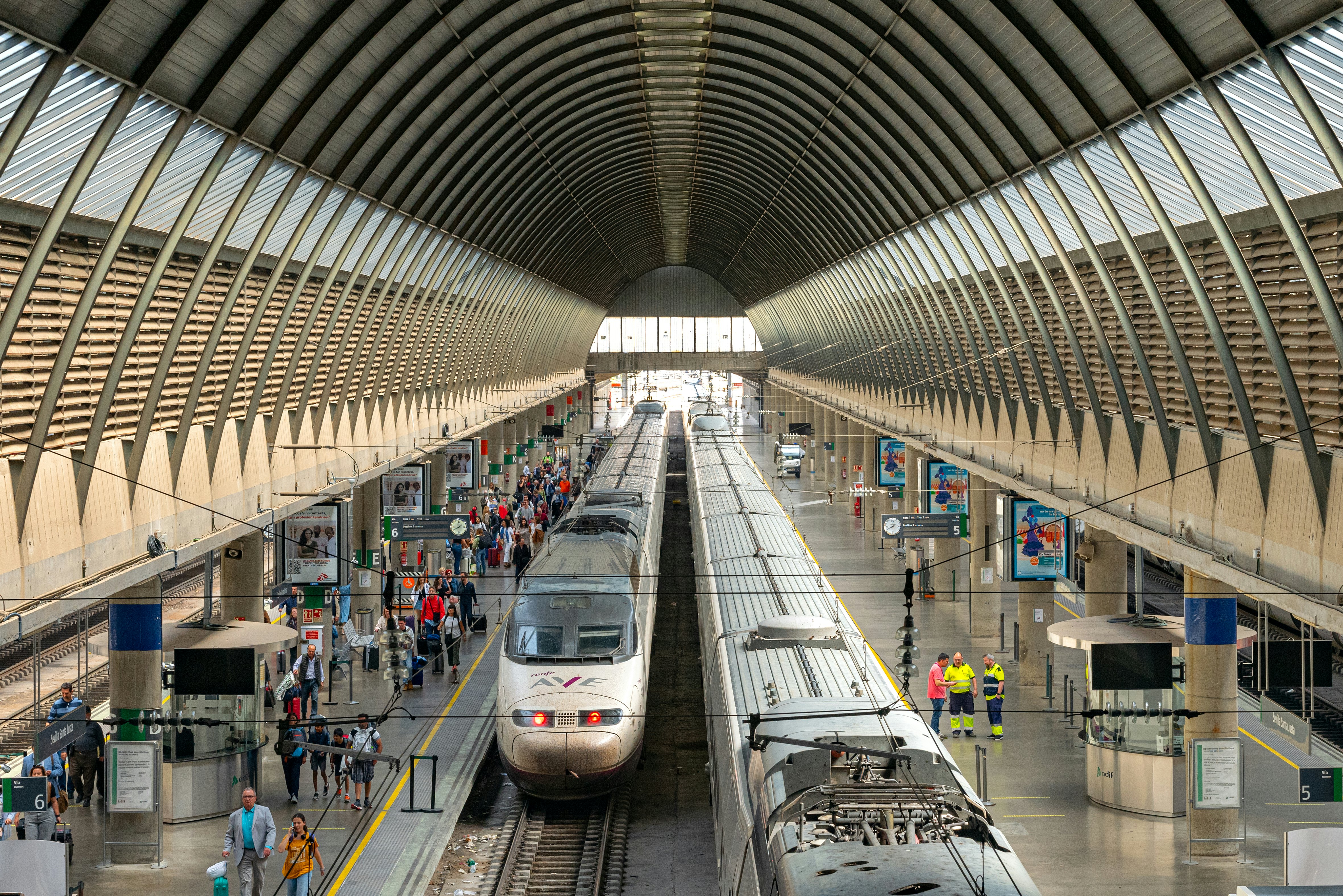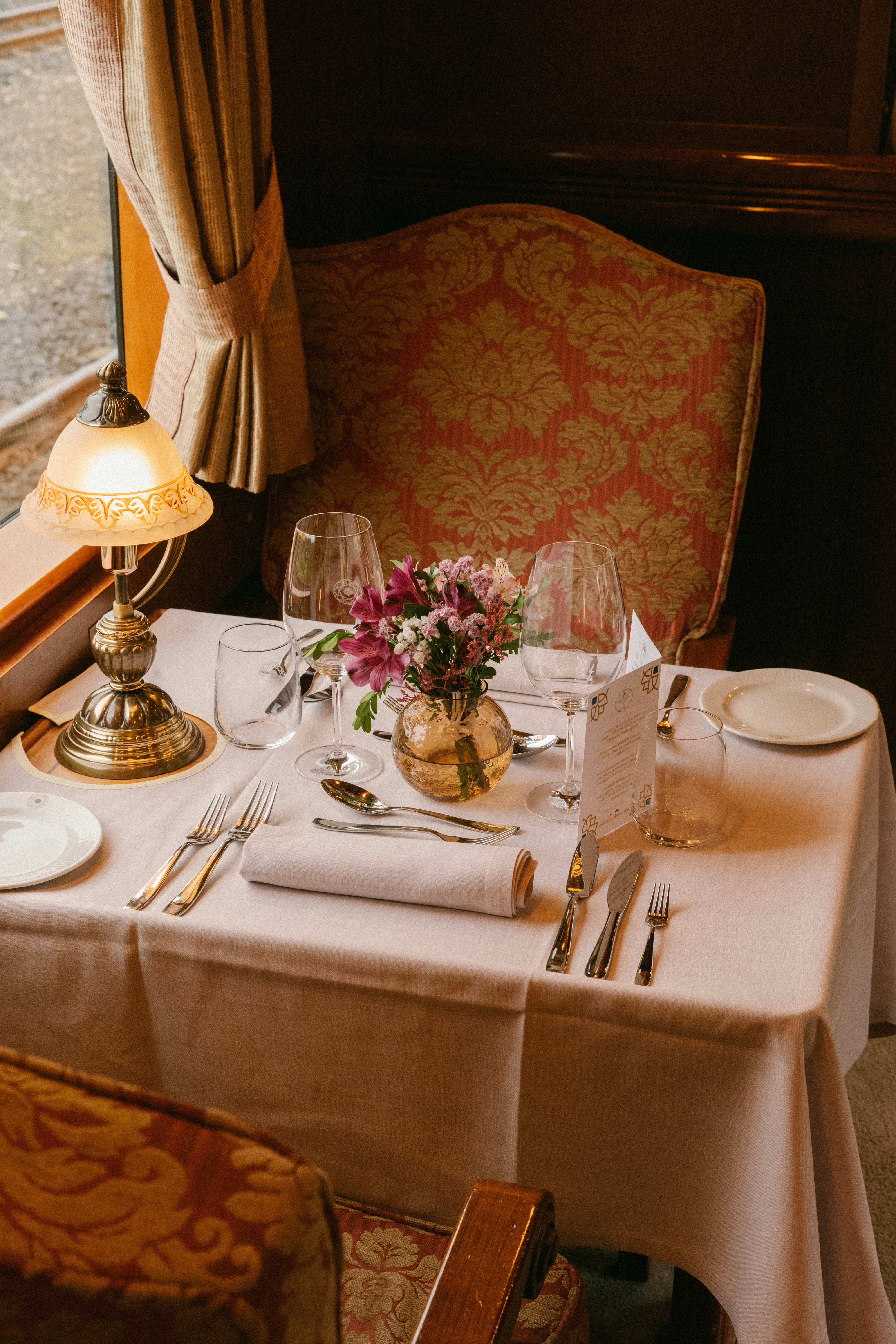
Spain by train: sustainable connections are a treat
Sponsored by

Jul 17, 2024 • 6 min read

The Costa Verde Express winds its way through northern Spain between Ferrol and Viveiro. From low-cost commuters to luxury trips of a lifetime, Spain is a joy to traverse by train. James Jackman for Lonely Planet
With Europe’s longest high-speed rail network, Spain is a joy to traverse by train. Such is the efficiency of its most sustainable mode of public transport that in a single day you can admire Gaudí’s Modernist architecture in Barcelona in the morning, have lunch in Madrid, and then be in Seville in time for dinner and a flamenco performance.
But there’s more to train travel in Spain than speed: slower journeys along Green Spain’s narrow-gauge northern tracks, and scenic meanders into Andalucía’s mountains are a wonderful way to acquaint yourself with Spain’s diverse scenery. Whether you opt for a wallet-friendly cercanías train ticket or splurge on a multi-day extravaganza aboard the luxurious Transcantábrico train, you’re in for a treat.

Spain’s train services
Most trains are operated by Renfe, Spain’s national railway company. These include high-speed long-distance AVE (Alta Velocidad Española) intercity services that reach up to 193mph; its low-cost competitors are Avlo, Iryo and Ouigo services. High-speed routes include Barcelona – Madrid, Madrid – Seville, Madrid – Valencia, and Córdoba – Málaga (for a complete list, visit the AVE website). Avant is Renfe’s brand name for high-speed, short-distance hops such as Madrid – Valladolid and Barcelona – Girona; they tend to be single cars on long-distance AVE services.
Mid-distance (media distancia) Alvia and Intercity services reach speeds of up to 155 mph and cover routes such as Barcelona – Pamplona, Madrid – San Sebastián, and Madrid – Cádiz.


Slower Renfe trains include Cercanías (the equivalent of Catalonia’s Rodalies) commuter services. In addition, some slower scenic routes are run by regional operators such as Euskotren that connects Irun and Hendaye’ on the French border to Bilbao and San Sebastián via narrow-gauge tracks. Other narrow-gauge services along Spain’s north coast include Bilbao – Santander and Gijon – Ferrol, while Barcelona is connected to the Montserrat monastery via the slow, picturesque FGC route.


Booking tickets
Since dynamic pricing is used by Spain’s rail operators for high-speed and long-distance services, and since seat reservations are mandatory, it pays to book ahead. Iryo and Ouigo release tickets for early purchase months in advance; Renfe’s ticket release varies from 11 months to 15 days, depending on the route. Book your ticket via the Renfe website or Trainline.
Travel on long-distance and mid-distance trains is divided into Standard (2nd class or Estándar) and Comfort (1st class or Confort) classes. Fares are divided into Básico (basic, non-refundable, valid for 2nd class travel); Elige (semi-flexible, valid for 2nd class or 1st class if you pay an Elige Confort fare); and Premium (flexible fare for travel in 1st class on AVE or Euromed services, with an airline-style meal with wine included. Cercanías tickets cannot be purchased in advance; buy them from ticket offices, self-service machines or onboard from the conductor.
For traveling from A to B, an advance-purchase ticket is ideal, but if you’re looking for flexible travel within the space of a month, Renfe offers a Spain Pass to travelers living outside Spain, valid for 4, 6, 8 or 10 individual one-way journeys on all of Renfe’s long-distance and medium-distance trains.The Costa Verde and Transcantábrico train routes are the jewels of Spain's tracks. James Jackman for Lonely Planet
The Costa Verde and Transcantábrico train routes are the jewels of Spain's tracks. James Jackman for Lonely Planet
Special trains
You can experience some of Spain’s most stunning landscapes and characterful cities from the comfort of ‘palaces on rails’ that hark back to luxurious railway journeys of the past. The best-known and oldest of Spain’s luxe train routes is the Transcantábrico, which traverses Green Spain between San Sebastián in the Basque Country and Galicia’s Santiago de Compostela in 8 days, stopping in Bilbao, Santander, Gijón and Oviedo. During the day, you’ll take part in bilingual guided excursions to the cities’ top attractions, then return to their luxurious wood-paneled suites, enjoy panoramic views from the train’s lounges, and dine on the latest in Spanish cuisine while listening to live music.
The Al-Andalus train takes in the architectural and cultural highlights of the likes of Úbeda, Córdoba, Granada, Ronda, Seville and Jerez while traveling between Málaga and Cádiz over the course of a week. You reside in carriages identical to those that once transported the British royal family between the Côte d’Azur and Calais, while sampling the best of Andalucían cuisine, from jamón iberico bellota to aged sherries.
In the north of Spain, the 3-day/2-night La Robla Express makes the journey between Bilbao and León, combining contemporary art and centuries-old architecture with the gastronomy of Green Spain.

Multi-day journeys-of-a-lifetime aside, there are numerous themed day routes that typically run between April and November. These include Catalonia’s Tren dels Llacs, with lovingly restored vintage carriages, that explores the highlights of the Lleida province, from the the Aigüestortes y Estany de Sant Maurici National Park to artisan cheesemakers. Galicia’s themed trains take in the Rías Baixas Wine Route, the Cheese Route, the Lighthouse Route and the Monasteries Route, among others.
In Madrid, you may board the Cervantes Train to Alcalá de Henares, the birthplace of Spain’s iconic author, alongside actors in 17th-century costume, hop aboard the Medieval Train to Sigüenza, accompanied by minstrels, knights and princesses; or visit the Monastery of San Lorenzo de El Escorial aboard the Philip II Train. Finally, the restored early-20th-century carriages of Andalucía’s Tren Turístico de Riotinto pass through a Martian landscape, where minerals have been mined since Roman times, following the course of the crimson river.
Particularly scenic routes
Some highly affordable regular train routes showcase Spain’s natural beauty. The three-hour journey from Granada to Andalucía’s coastal city of Almería (€17) gives you tremendous vistas of the snowcapped Sierra Nevada peaks while crossing its foothills, before you duck into cork-oak groves and get your first glimpse of the Mediterranean.
For under €10, step into 19th century Andalucía by riding the rails from the industrial port of Algeciras into the mountains to the spectacular pueblo blanco of Ronda. An impressive feat of engineering involving 16 tunnels and 20 bridges, the line was built by the British and opened in 1892. During the two-hour journey, the train passes through orange and olive groves, cork-oak and eucalyptus forest and meanders among russet-colored mountains and rugged cliffs, stopping at tiny stations with antique clocks and fringed wooden canopies. A similarly scenic journey can be made between Ronda and Málaga, at nearly double the price

Bay Biscay
If the Transcantábrico is beyond your reach, you can still enjoy many of the same panoramic views of the Cantabrian mountains and the Bay of Biscay during the 5½- 7 hour ride from Santander, Cantabria to Oviedo, Asturias on a cercanías train (from €16). Since seat reservations are not possible, that works in your favor as you switch sides to take in views on either side of the train.


Fisterra’s lighthouse in A Coruña
One of Spain’s longest rail routes (from Barcelona to A Coruña) traverses fertile farmland and arid plains studded with rock formations, before passing the verdant Galician Massif and reaching the Atlantic. Your best bets are either the 9.05 Alvia departure (14 hours, €66), or the swifter but pricier 10am Avlo departure (8 hours and 15 minutes, €82); reserve a seat on the right-hand side.
Stellar mountain panoramas are your reward for taking one of the twice-daily trains from Zaragoza to Canfranc (2½ hours, €13.50) that makes its ponderous way up into the Aragonese Pyrenees, and finally arrives at the 1920s concrete-and-glass station, transformed into a luxury hotel.
Sponsored by Turespaña
As a travel entertainment and inspirational media outlet, we sometimes incorporate brand sponsors into our efforts. This activity is clearly labeled across our platforms.
This story was crafted collaboratively between Turespaña and Lonely Planet. Both parties provided research and curated content to produce this story. We disclose when information isn’t ours.
With sponsored content, both Lonely Planet and our brand partners have specific responsibilities:
-
Brand partner
Determines the concept, provides briefing, research material, and may provide feedback.
-
Lonely Planet
We provide expertise, firsthand insights, and verify with third-party sources when needed.























